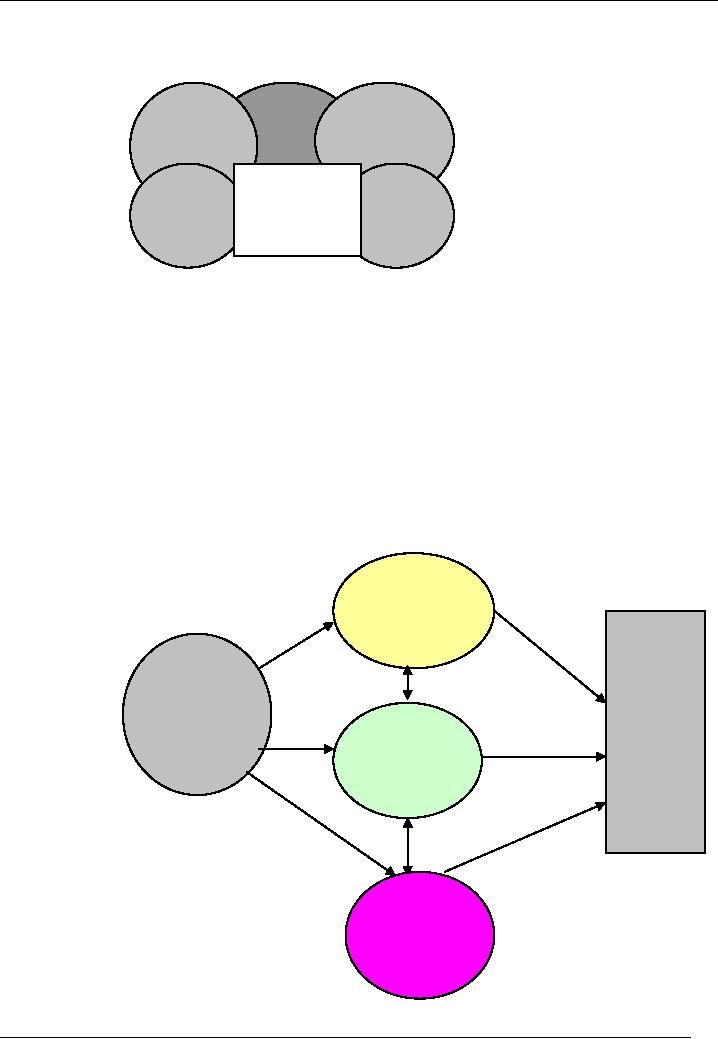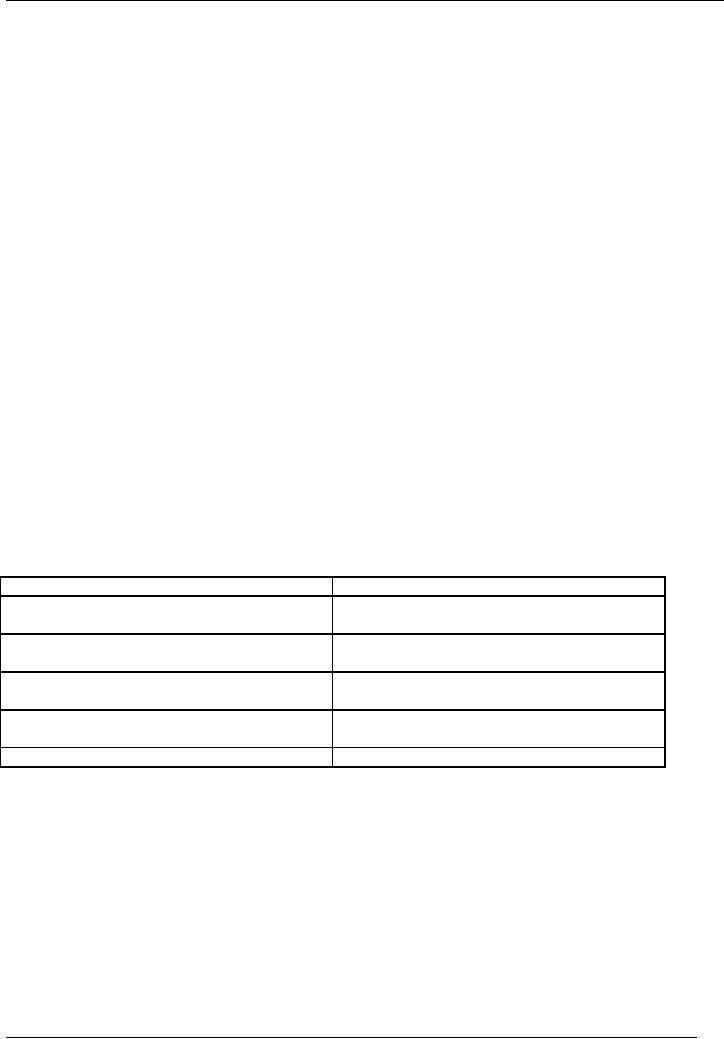 |
LEADERSHIP:ORGANIZATIONAL DEMOCRACY |
| << CREATE YOUR OWN BLUEPRINT |
| LEADERSHIP:Environment and Strategic Leadership Link, Concluding Remarks >> |

Human
Resource Development (HRM-627)
VU
Lesson
14
LEADERSHIP
Organizational
Democracy and Organization Structure
Link: Role of Strategic
Leadership &
Environmental
Uncertainty
Abstract
This
theoretical paper focuses on the issue of
implementing democratic principles in modern day
organizations
facing
turbulent and changing environments
around them. The paper
captures the notion of participatory
style
of
management through the construct;
organizational democracy. It traces the
origin of this construct
from
theories
and philosophies of political democracy.
The paper also briefly
describes the notion of
economic
democracy
and why it failed to succeed
in the face of partial success of
political democracy. The
underlying
question
which the paper raises is the
role of organization structure and
strategic leadership style in
the
successful
implementation of democratic principles in
organizations in the face of a turbulent
and dynamic
environment.
The paper also attempts to
raise some thought provoking
questions for future
research.
INTRODUCTION
People
who grew up feeling comfortable and
secure working for a manufacturing
firm appreciate just
how
elusive
stability and security are
in these days when the companies
across the globe are feeling the
enormous
impact
of globalization on their style of
work, leadership, communication,
reporting mechanisms, and
other
structural
and contextual dimensions of present-day
companies. There are a number of ways in
which
organizations
are coping with the reality of
globalization and the need
for `organizational excellence'
focus is
realized
to be more than any other
time in industrial history. Recent
research has identified four
threads of
corporate
excellence (Daft, 2000, pp.
483). These include, strategic
orientation (customer-driven,
fast in
responding,
ability to establish interorganizational links),
top
management leadership style
(leadership
vision, bias
towards
action & change), organization
design (horizontal
structure, empowerment of employees,
use of
electronic
technology & e-commerce) and,
corporate
culture (creating
a climate of trust, sharing
information,
encouraging
productivity through
people).
The
impact of globalization is no doubt
different for different
industries. The high-velocity
industries like
electronics
and information technology are
probably more exposed to the
impact of globalization as
compared
to
typical manufacturing industries, but in
general, the focus on `productivity
through people' (Hitt &
Ireland,
1999)
has largely meant a
participatory style of management
and decision-making. This
paper presents the
notion
of organizational democracy to capture the
participatory management style
within a company and
also
examines
the relationship between this participatory
style and other dimensions
of the company like
strategic
leadership
style and turbulent
environment.
HISTORY
AND BACKGROUND OF ORGANIZATIONAL
DEMOCRACY
The
term democracy originated from Greek
word demokratia
where
demo
means
people, and kratia
referring
to
power
or rule, so democracy means rule of the people
(Powley et
al. 2004).
The Greeks were no doubt the
first
to
try to build political
philosophy theories and Plato
equated the three elements of
human soul with the
three
elements
of an ideal or just state
(Moore & Bruder, 2001,
pp. 266). His notion of
democracy is however a
degenerated
form of plutocracy which results
because, "a society cannot hold wealth in
honor and ......
establish
self-control in its citizens" (Republic).
Aristotle too regarded state
as an organism and
defined
democracy
as an improper rule by
many.
Later
on, during the period of
renaissance, Nicolo Machiavelli's
The
Prince (1532)
was labeled as, "one of
the
most
famous political treatise of
all times" (Moore &
Bruder, 2001, pp. 272). In
fact Machiavelli established
his
reputation
as the first one to advocate the
notion of power politics. Lock, Rousseau,
John Stuart Mill,
all
mentioned
"liberty" and "happiness" as essential
ingredients of good governance.
By
19th Century, Karl Marx (1818
1883) brought in the issue of
"class struggle" in the governance of
a
society.
He also attacked the foundations of
capitalist theories by pointing
out that workers produce
the
product
but don't own it!
Be
it in the West or in the "form of varna
and jati in Hindu society"
(Presby, Struhl & Olsen, 2000,
pp. 591) in
East,
most of the philosophers who wrote on
politics and its philosophy
mention the classes in society
and the
need
for a fair and transparent
governance system to bring
these classes and factions together in
the
formulation
of a solid and whole system of
political governance.
40

Human
Resource Development (HRM-627)
VU
The
20th Century
is therefore labeled as the "century of
democracy" as the older versions of
democracy
improved
in quality and further
experience was gained in
governance through democracy
and one can
witness
that
from 1985 to 2000, the number of
most democratic countries in the
world increased from 44 to 82
and the
number
of authoritarian regimes declined
from 67 to 26 (Ringen,
2004).
Economic
democracy, on the other hand has
not witnessed such
successful proliferation as its
political
counterpart.
Though it seems logical that
economic democracy follows
from the democratic principles and
that
economic
power should also be under the democratic
control but in contrast to
political democracy,
economic
democracy,
"does not appear to be something people
are ready to take to the
streets and fight for"
(Ringen,
2004).
In the same article on distributional
theory of economic democracy,
Ringen (2004) captures the
failure
of
economic democracy in the following
way:
"Various
attempts can be identified
through the last century of subordinating
economic resources and
activities
to
political control, all
failures. The extreme case
is that of Soviet-style command
economy......British style
nationalization
of heavy industry......French socialists'
move under President Mitterrand to
nationalize major
banks......Swedish
idea of bringing capital under
democratic control".
All
of these above mentioned endeavors
enjoyed brief success but
none lasted long.
The
advocates of the concept of Inclusive
Democracy recognize this failure
and are of the view that,
"the
world
is in a multidimensional crisis, caused by
concentration of power in the hands of various
elites, as a result
of
the establishment of the economic system
of market/growth economy, its
political complement in the
from
of
representative democracy" (Gezerlis,
2003). The principle of
political democratic equality understood
as
"one
man one vote" does
not probably apply to economic
democracy and a recent case
study of political
decision-making
in Skanderburg, a small town in
Denmark only confirms this (Sorensen
& Torfing, 2003).
Even
the modern political democracy is seem to
be under attack from factors
like, "commercialization of
education,
media consolidation, news
uniformity......extension of application of
psychology from the
cultivation
of consumer tastes to the cultivation of
political ideology and voter
perception......and a consumer
culture
that has elevated material
wealth to be all, end all" (Swaney,
2003).
It
would now be interesting to pose the
question: Why various efforts
and experiments to launch
economic
democracy
failed? Why the theory that
political control over the
economy would be conducive to
economic
efficiency
did not work?
The
answers to these questions
seem to lie in the "big
tradeoff" of the economist Arthur
Okum, according to
which
citizens in democratic societies
value both prosperity and equality, they
want equality but not at the
cost
of
prosperity (Ringen, 2004). Slowly and
gradually issues like
poverty, income inequality
have been absorbed in
the
society with little or no
political resistance. Political equality
has been somewhat achieved
in equal rights
and
the universal vote (at least
in the developed countries) while
economic equality has been given up,
even in
these
advanced societies, as it not
possible without incurring
prohibitive costs. Can we
imagine a society
where
everyone
has the same economic power?
The answer to this question seems to be
no as it's understood that
real
economies are comprised of
different classes of people with
uneven economic power, in
contrast to
political
power, which is more or less
equal as one man has
only one vote, whatever
his/her economic
resources
may be. Society has an
upper, middle and lower
class in terms of income and
prosperity, though
each
person
within these classes has the
same political power of one
vote. Laclau noted earlier
that, "power which is
equally
distributed among all
members of the community is no power at all"
(Marchart, 2003), one can
infer
that
the control and acquisition of economic
resources is power as it is not equally
distributed across
any
society
in the world.
The
political democracy, on the other
hand, has seen some
success and is probably one
of the reasons of
successful
integration of the `melting pot' culture of America as
it has forged a single
nation from people of
remarkably
diverse racial, religious, and ethnic
origins through democratic principles and
participatory
democracy
(Braceras, 2005). Political
democracy has to its credit the
adoption of Civil Rights Act
of 1964 to
redress
and to eliminate inequality in the treatment of
Black Americans. Samuel
Loescher while examining the
merits
of a corporate progressive value
added-tax to induce spin-offs by corporate
giants to enlarge pluralism,
notes
the same merits of political
democracy in including people to rise,
but voices the above mentioned
`big
tradeoff'
question when he asks, "would
adoption of any of these
alternatives (tax incentives) be
as
economically
efficient a use of citizens' `love'
for our democratic
environment as a massive citizens'
campaign
for
tax incentives to limit corporate power?"
(Loescher, 1979).
The
next natural question to rise is: If
economic democracy has
failed due to non homogenous
society in terms
of
income inequality and class
struggle, can organizational democracy
succeed in organizations?
41

Human
Resource Development (HRM-627)
VU
ORGANIZATIONAL
DEMOCRACY
The
idea of political democracy, as we
have already seen, is deeply
ingrained in Western culture. It is
not
surprising
therefore if the organizations based in the
Western economies are viewed as natural
setting in which
to
extend democratic values and
practices (Kerr, 2004). Organizational
democracy means that members
of an
organization
participate in the processes of organizing and
governance (Harrison et al.
2004). There is no doubt
that
the idea of applying democratic principles to
organizations is appealing. It is argued
that increase `voice'
(Fenwick,
2005) of the employees ( as a result of
democratic principles) would lead to
higher level of
organizational
commitment which would further
improve implementation rates of the
decisions made,
reduce
dysfunctional
behavior in employees and
upgrade their skills and
abilities due to more participation
which
would
ultimately lead to improved
organizational performance and
productivity.
But
the literature also points out
that organizational democracy practices
do not reach out the
lowest
employees
as they are not in a position to
capture the `big picture' of
organizational governance and hence
the
quality
of their decisions will be
compromised and not up to the
mark of organizational
requirements
(Harrison,
et
al. 2004).
It is also mentioned that organizational
democracy is a time consuming process
which
demands
sweeping changes, and fierce
resistance from various
worker groups and clash of
interest of different
corporate
players would make it even
more time consuming and
difficult to implement in the
organizations.
Organizations
are after all much like
societies in the sense that they
are not homogenous and
parallel the rich,
middle
and poor classes of society
as top, middle and lower
management hierarchies in organizations.
In real
economies
there is a surplus and no equality
(Ringen, 2004) and similarly in
organizations there is profit
with
minimum
equality among organizational members. If
economic democracy has
failed in society, in the face
of
success
of political democracy, can we
not assume that democracy in
organizations, which are
structured more
or
less like societies, is doomed
for failure as well? Is it
not the nature of an organizational
person to grasp
power
rather than sharing it or giving it
up?
These
questions at least caution us to the fact
that trying to blindly duplicate
political democracy in
organizations
will end up in failure and
trouble. The recent
researchers define corporate democracy
as,
"referring
to a system of democratic governance
embedded in a supportive
organizational structure that
includes
shared
residual claims by all
members in combination with
democratic decision-making rules"
(Harrison, et
al.
2004).
We
can see that this definition of
organizational democracy is subject to `supporting
organizational structures'
as
a main moderating variable which will
decide the fate of the application of
democratic principles in
organizations.
The conceptual and
structural differences among
different organizations are explained
aptly in
the
following paragraph:
"Some
(organizations) are truly
command-and-control organizations where
attempts by employees or
managers
to
be more democratic are
disparaged by owners and
senior executives......A few
organizations are built
not
just
on democratic principles but are in fact
`democratically designed communities'
where ownership,
employment
and business processes are
all aligned to create viable entities
that achieve a high level
of
results......While
larger organizations have
difficulty transitioning to a full
democracy, many smaller
companies
have
embraced a systemic approach
called `open book
management'" (Caimano,
2004).
In
the nutshell, the organizational democracy principles
can be summarized as
follows:
·
Participative
management practices
·
Increased
`voice' of employees
·
Focus
on change
The
basic theory underlying my proposed model
of organizational democracy implementation in
organizations
is
based on the interaction between
its structural
and
contextual
dimensions.
Organizational dimensions fall
into
two
categories: structural and contextual.
Structural dimensions provide
labels to describe the
internal
characteristics
of an organization and include degree of
formalization, specialization, centralization in
decision-
making,
breadth of the span of control and,
length and width of the hierarchy,
while the contextual dimensions
characterize
the whole organization, including its
size, technology, environment, and
goals (Daft, 2000, pp.
16,
17
& 18). These dimensions of
organizations design interact with
one another as shown in Figure 1.
42

Human
Resource Development (HRM-627)
VU
Size
Environment
Goals
Structure
Culture
Technology
1.
Formalization
2.
Specialization
3.
Hierarchy
4.
Centralization
Figure
1:
Interacting Contextual and
Structural Dimensions of Organization
Design
Adapted
from Daft, 2000, pp.
17: Organization Theory &
Design
The
above shown interaction of the contextual
and structural dimensions of the
organization determine the
unique
design of that organization and
research has proved that
these dimensions or variables
are
interdependent,
e.g., large organization size, a
routine technology, and a stable
environment all tend to
create an
organization
that has greater
formalization, specialization, and
centralization (Daft, 2000, pp.
20) or mechanistic
structure
(Daft, 2000, pp. 144;
Sharfritz & Ott, 2001, pp.
201). Similarly, a medium size, a
non-routine
technology,
and a turbulent and dynamic
environment tend to create an
organization that has
lesser
formalization,
specialization, and centralization or in
other words, an organic
structure.
Figure
2:
Theoretical
Organic
Framework
Structure
Linking
Successful
Organizational
Implement
Democracy
to
ation
of
Organization
organizations'
Organizati
al
Democracy
Structure,
onal
Principles
Strategic
Democracy
Leadership
Empowering
Style
and
Strategic
Turbulent
Leadership
Environment.
Double-arrows
indicate
interdependencies
.
Turbulent
Environment
43

Human
Resource Development (HRM-627)
VU
The
underlying theory of my proposed model
for successful implementation of
organizational democracy is
therefore,
embedded in the current literature on organizational
theory. Since organizational democracy
requires
participative
style of management, the best
suited structure to achieve this
would be a free flowing
organic
structure
and not the rigid
mechanistic structure. In the sections to
follow, I will address how
successful
implementation
of organizational democracy depends on the
presence of supportive organizational
structure
and
two additional variables;
strategic leadership style
and change (captured by the
environmental uncertainty).
My
proposed model is shown in Figure 2. This
figure is not meant to be a
full-blown theoretical model, but
it
does
summarize and integrate some
of the findings of the previous research, along
with my structure-based
predictions.
For example, my contention on the
connection between successful
implementation of
organizational
democracy and organization structure is
that the relationship between the two
would be
augmented
in the presence of two additional
variables; a dynamic strategic
leadership on top of an
organic
structure
and with a turbulent
environment around the organization.
The
link of organizational democracy with
supportive organizational structure,
strategic leadership
and
turbulent
environment is now described in
some detail.
Supportive
Organization Structures and
Organizational Democracy
Most
organizational theorists like Taylor
and Perrow have determined two
definitions of organization
structure
and
have evolved the concept of
mechanistic versus organic
structures (Kennedy, 1983; Ambrose &
Schminke,
2003).
Organizations
have a mechanistic or organic
structure not because they
like to have one, it is
because of a
particular
type of product/service which the
organizations is offering and to the
degree of environmental
stability
or the lack of it, around that
organization which defines and
imposes the structural requirements
on
the
organizations. Burns and
Stalker observed that external
environment was related to the
internal
management
structure to the extent that when
external environment was stable, the
internal organization was
characterized
by rules, procedures and a
clear hierarchy of authority.
The opposite was observed to be
true
when
the external environment confronting an organization
was complex and dynamic.
These organizations
tended
to have loose, free-flowing
and adaptive organic
structure (Daft, 2000, pp.
144). Various authors
and
researchers
in the field of organization theory have
developed sets of characteristics which
are intrinsic to
mechanistic
and organic structure. The
following table summarizes
some of these
characteristics:
Table
1
Mechanistic
Structure
Organic
Structure
1.
Tasks are broken down
into specialized
1.
Employee contribute to the common tasks
of
separate
parts
the
department
2.
Tasks are rigidly
defined
2.
Tasks are adjusted and
redefined through
teamwork
3.
There is a strict hierarchy of authority
and 3. There's less
hierarchy of control and
authority,
control,
rules are many
there
are few rules
4.
Knowledge and control of
tasks are 4. Knowledge and
control are located
anywhere
centralized
in
the organization
5.
Communication is vertical
5.
Communication is horizontal
Source:
Adapted from Richard L.
Daft, 7th edition, 2001
These
two above mentioned structures
are in reality the two formally
contrasted forms of management
systems,
a mechanistic management system
which is appropriate in stable conditions
and the organic form
which
is appropriate to changing conditions (Shafritz &
Ott, 2001, pp. 201-
201).
Michael
Porter's framework of competitive
strategies of either low cost
leadership or differentiation
also
captures
the same structural differences among
organizations as a result of their
interaction with the
environment.
His low cost leadership
strategy where the organization
aggressively seeks efficient
facilities,
pursue
cost reduction, and uses
tight controls to produce the product
more efficiently (Daft,
2001, pp. 60) is
clearly
more suitable for
mechanistic organizations rather than
organic forms where the strategy
of
differentiation,
characterized by organizational attempts to
distinguish their products or services
from others,
would
be more suitable.
Broadly
speaking, one can conclude
that organizations with an efficiency
focus would be more prone to
have a
mechanistic
form and organizations which
focus on effectiveness (or
are less concerned with
efficiency) would
44

Human
Resource Development (HRM-627)
VU
do
better with an organic structure. In a
business context, increased efficiency
can result from providing
greater
output
for a fixed set of inputs, by marinating
output at reduced levels of
input or combining the
two
approaches,
the inputs are generally
seen as costs which are
usually minimized in order to achieve
efficiency
(Bronn
et al. 2005). Other
researchers have also
defined organizational efficiency as
cost-effectiveness or value
for
money (Smith & Street,
2005; Lear & Fowler,
1997) and as fostering, "intra
firm compromises
economically"
(Gellner, Frick & Sadowski,
1997). It is also mentioned in the literature
that corporate efficiency
is
measured in terms of productivity
because increased productivity
leads to more competitive
cost structure
and
the ability to offer more
competitive products and services
(Chowdhury, 2005).
The
discussion so far has yielded
that organizational democracy cannot be
blindly applied across
all
organizations.
There seem to be some prerequisites or
some, "internal conditions
that facilitate......democratic
organizations"
(Rothschild & Whitt, 1986, pp.
172). I now enlist some of
these prerequisites of
organizational
democracy:
1.
a more provisional sense of
temporality towards organizations
than that of
bureaucracy
2.
a climate (culture) in which constructive mutual
and self-criticism can
flourish
3.
small size
4.
homogenous membership in terms of
backgrounds and
values
5.
a turbulent and dynamic
environment around the organization so that the
organization's main focus in
innovation
and idea generation (differentiation)
rather than efficiency (cost
leadership)
6.
a team culture
7.
an internal environment where
employees trust each other
and this trust is emanating from
the
leadership
of the organization
8.
a horizontal and flat organization as
opposed to a tall and vertical
one
A
comparison of the above mentioned
prerequisites with the structural
characteristics mentioned in Table
1
clearly
demonstrates that organic
organizations with horizontal
communication, employee participation,
less
vertical
hierarchies and decentralization would be
much more suited for the
practice of democratic principles
than
a large and tall
bureaucratic organization.
Even
in organic organizations the assumption
that organizational democracy would
work like political
democracy
is a far fetched idea. The
top management of organizations is
not elected representatives
like
members
of a politically elected government and
employees, specially the lower
cadre employees, cannot be
expected
to understand the longer-term repercussions of
their decisions and hence
the quality of these
decisions
can be challenged. But organizational
democracy in large and
bureaucratic organizations seems
just
out
of question. In mechanistic organizations
it's not the people but rules
and procedures and their
meticulous
implementation
which makes possible the
successful realization of a cost
leadership strategy in their
intensely
competitive
but relatively stable environments. There is
little scope for `participatory'
management systems in
mechanistic
organizations and hence
little scope for the
practice of democratic principles in
these
organizations.
On
the basis of the discussion so far,
following is the first proposition of
this paper:
Proposition
1: Organizational
democracy would be implemented more successfully in
organizations with an organic
structure.
45
Table of Contents:
- INTRODUCTION TO HUMAN RESOURCE DEVELOPMENT:The Concept and its Dimensions, Targets of Development
- FOUNDATIONS OF HUMAN BEHAVIOR:Attitudes, Personality, Emotional Intelligence
- PERCEPTION:Attribution Theory, Shortcuts Frequently Used in Judging Others
- INTRINSIC MOTIVATION:Why Choose Big Five Framework?, THE OUTCOME OF FIVE FACTOR MODEL
- FIVE FACTOR MODEL:The Basis of Intrinsically Motivated Behavior, Intrinsic Motivation and Values
- MOTIVATION:EARLY THEORIES OF MOTIVATION, Designing Motivating Jobs
- The Motivation Process:HOW TO MOTIVATE A DIVERSE WORKFORCE?,
- INTERPERSONAL COMMUNICATION:PRINCIPLES OF INTERPERSONAL COMMUNICATION
- THE WORLD BEYOND WORDS:DIFFERENCES BETWEEN VERBAL AND NONVERBAL COMMUNICATION, MINDFUL LISTENING
- TRANSACTIONAL ANALYSIS:EGO STATES, Parent Ego State, Child Ego State
- TYPES OF TRANSACTIONS:Complementary Transactions, Crossed Transactions, Ulterior Transactions
- NEURO-LINGUISTIC-PROGRAMMING
- CREATE YOUR OWN BLUEPRINT
- LEADERSHIP:ORGANIZATIONAL DEMOCRACY
- LEADERSHIP:Environment and Strategic Leadership Link, Concluding Remarks
- UNDERSTANDING GROUP BEHAVIOR:Stages of Group Development, Advantages of Group Decision Making
- UNDERSTANDING TEAM BEHAVIOR:TYPES OF TEAMS, Characteristics of Effective Teams,
- EMOTIONAL FACET:PHYSICAL FACET
- HUMAN RESOURCE DEVELOPMENT & THE ROLE OF GOVERNACE:Rule of Law, Transparency,
- HUMAN RESOURCE DEVELOPMENT:The Concept and Its Dimensions, Targets of Development
- HUMAN DEVELOPMENT INDEX (HDI):Methodology,
- REPORTS:Criticisms of Freedom House Methodology, GROSS NATIONAL HAPPINESS
- SECTORS OF A SOCIETY: SOME BASIC CONCEPTS:PUBLIC SECTOR, PRIVATE SECTOR
- NON GOVERNMENTAL ORGANIZATIONS (NGOS):Types, Methods, Management, Citizen organization
- HEALTH SECTOR:Health Impact of the Lebanon Crisis, Main Challenges,
- A STUDY ON QUALITY OF PRIMARY EDUCATION BACKGROUND AND RATIONALE
- ADULT EDUCATION:Lifelong learning
- THE PRACTICAL PERSPECTIVE OF ADULT EDUCATION:Problems of Adult Literacy, Strategies for Educating Adults for the Future
- TECHNICAL & VOCATIONAL EDUCATION:VET Internationally, Technical Schools
- ASSESSING THE LINK BETWEEN INTELLECTUAL CAPITAL FORMATION AND PERFORMANCE OF A UNIVERSITY
- SCIENCE & TECHNOLOGY EDUCATION:Social responsibility, Curriculum content
- ENVIRONMENT:Dark Greens and Light Greens, Environmental policy instruments
- HDI AND GENDER SENSITIVITY:Gender Empowerment Measure
- THE PLIGHT OF INDIAN WOMEN:
- ENTREPRENEURSHIP:Characteristics of entrepreneurship, Advantages of Entrepreneurship
- A REVISIT OF MODULE I & II
- HUMAN DEVELOPMENT & ECONOMIC GROWTH (1975 TO 2003):
- PUBLIC PRIVATE PARTNERSHIP:Origins, The Desired Outcomes of PPPs
- PRINCIPLES OF PUBLIC PRIVATE PARTNERSHIP (PPP):Situation in Pakistan,
- DEVOLUTION REFORMS – A NEW SYSTEM OF GOVERNMENT:
- GOOD GOVERNANCE:Participation, Rule of law, Accountability
- MACROECONOMIC PROFILE OF A COUNTRY: EXAMPLE ECONOMY OF PAKISTAN
- COORDINATION IN GOVERNANCE: AN EXAMPLE OF EU, The OMC in Social Inclusion
- MOBILIZING REGIONAL EDUCATIONAL RESOURCES: THE ASEAN UNIVERSITY NETWORK, A CASE STUDY
- GOVERNMENT PRIORITIES AND POLICIES:Role of Government, Socio Cultural Factors in Implementing HRD Programs